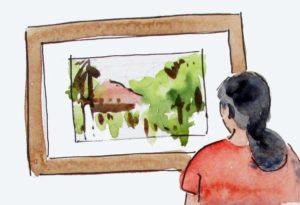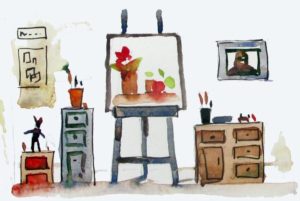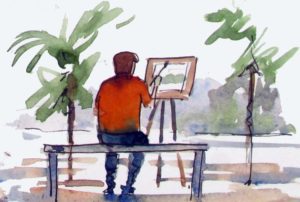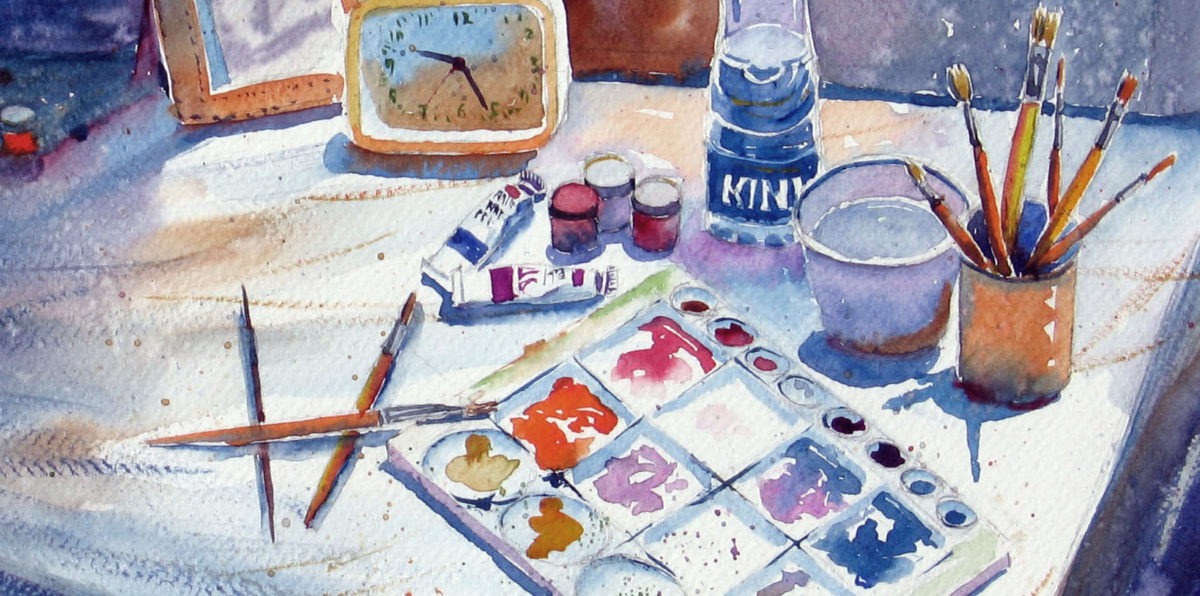One of the most common questions that I get from people from different walks of life is this. “How do I start painting with watercolour or how do I approach watercolour painting?” And this is the exact question that I had in my mind before I started painting in watercolour. Earlier I used to paint only in opaque medium like oils and pastels. The transparent watercolour paintings remained an enigma for me until I did my first watercolour painting. And after my first attempt at the medium, watercolour puzzle became even more difficult to solve. Having painted in opaque medium all my life, painting in a transparent medium was like trying to walk on water. And the ‘lively’ nature of watercolour was not making things easy for me either. After my first few paintings in watercolour failed miserably, I had decided never to try watercolour in my life. But destiny had different plans. When I reflect on this now I am left to wonder about how many people on earth would be giving up on watercolour everyday. And the main reason I strongly feel behind this is the lack of proper guidance. Hence I thought it would be a good idea to write on “Watercolor painting for beginners”.
Inspiration before you begin with watercolour

I am sure if you are keen on starting with watercolour you must have been inspired by watercolour works of different people. But still it is not a bad idea to get inspired further. The first place to start is right in front of you. Just search the internet for watercolour master artists and look at their works. Look at works of watercolour artists from different parts of the world. Try and understand their approach to watercolour painting. It will give an idea about the endless possibilities of watercolour. Look at different subjects. See what are you drawn to most. And then go to your local gallery or some art show where you can get to see watercolour directly in front of you. Seeing a picture on the computer just can not match looking at a watercolour that is directly in front of you. In case you get a chance to talk to the artist in the gallery there is nothing like it.
Now that you have been inspired and roaring to go and paint your first masterpiece in watercolour, this is the exact time when you have to forget about things you have seen. Inspiration is good. But it can also become a baggage as you’ll start to compare your paintings with what you have been inspired by. Unless you are a genius who just cannot do anything wrong, your first watercolour painting is not going to be comparable to the works of masters. Hence there is no use of having astronomical expectation from yourself which can lead to de-motivation. In fact what you have to ponder on is that the first watercolour work of the maters may not have been as good as your first work. How about a little bit of positive thinking.
Watercolour supplies
The next thing that you need to do is to go and buy supplies. Most beginners of watercolor always end up buying a lot of unnecessary supplies. My advice would be to keep things simple and compact to start with. This is my suggested list of supplies that is enough to start painting in watercolor for beginners.
- Brushes – One each of 1 inch flat, No 12 Round, No 8 Round, No 4 round, No 6 Rigger brush is a great set to start with. Try and get natural hair brushes like sable or squirrel hair for the first three brushes mentioned as they would be able to hold more water and will be gentle on the paper. For the no 4 round get a synthetic hair brush. A stronger brush tip of the synthetic hair brush is good for details. I prefer a synthetic hair rigger just for the bounce it gives on paper.
- Palette – 8 to 12 well palette with 2 mixing areas is good enough. If you can get a foldable one, its even better because you can easily travel with it.
- Paper – Watercolour paper surface and quality are very important for a successful watercolour work. To start with you can get cold pressed paper, whose surface is somewhere between rough and hot pressed paper in texture. In case you can get hold of Indian handmade paper just buy it. Though it can be a bit inconsistent, the surface quality compared to the cost is unmatchable. A full imperial paper comes in the size of 22 x 30 inch. Divide each sheet into 8 parts. I would not recommend painting on any bigger size of paper when you start with watercolour painting. Gradually with experience you can increase the size of the paper. Alternatively you can buy a watercolour pad of similar size. But it will cost you more.
- Paints – Though you’ll want to try out all the colours and its different shades in the world in the beginning (just like I did) I would strongly discourage that. Working with a lot of colour initially will confuse you and make your work also look very confusing. So stick to a few basic colours to start with. My recommended list of paints is 2 shades of each primary, 1 shade each of secondary, a brown and a black. The list is as follows.
- French Ultramarine – Warmer blue
- Cobalt Blue – Cooler blue
- Vermilion – Warmer red
- Crimson –Cooler red
- Gamboge Yellow – Or any other brighter yellow
- Yellow Ochre
- Sap Green
- Orange
- Burnt sienna
- Paynes Gray
- Other tools – You’ll need a few other tools to paint in watercolours. These are a board and some paper clips, a cotton towel, pencil and a spray bottle. Some people ask me whether masking fluid is also needed. I strongly discourage the use of masking fluid for beginners. Use of masking fluid can cause bad habits to develop, which will be very difficult to correct later on.
Studio setup

Now that you have got your supplies you need a place to paint. If you can manage then try and get a quiet corner in your home or garage. Just put a table there are you are good to go. If you cant get a separate place for painting, then don’t worry, your study table or even your dining table is good. Watercolour is easy to clean up, pack and store. So just open your supplies on your dining table when you are not eating and store them away when you are done with your painting. However just make sure that the place is well lit up, so that you can easily see what you are painting.
Join a watercolour class
Bad habits are easy to develop and difficult to give up. Its true while painting in watercolours too. Hence find out a watercolour course in your area and join that. It is very difficult to find out your own mistakes, because while painting it is not easy to observe your own habits. An experienced teacher can easily find out the bad habits that you have or may develop. Additionally its good to get a hang of basic watercolour techniques like different kind of washes, wet in wet and dry brush techniques from an experienced teacher. In a short time you’ll be able to master these techniques if you learnt directly from a teacher, because again she will be able to guide you well on those. Books are good, but then they will not be able to tell you where you are going wrong in your approach to watercolor painting.
Another advantage of a class is that you’ll not be alone. There will be many others in the class and it is always fun to learn in a group. You’ll also be able to learn quite a bit from each other. So go ahead join a class and have fun.
Get outside

Most artists would tell you that Mother Nature is the best teacher of art. Painting outside in the lap of nature is an invigorating and refreshing experience. You’ll not only develop a keen sense of observation and colour when you paint outside, the sheer joy of painting outside will also improve your work. It may be a little difficult initially to stop worrying about all the curious people looking at what you are doing and probably judging your work. But with frequent outdoor session you’ll get over these issues.
While painting in the open or en plein air you’ll have to work faster than your usual pace. You’ll also have to work with a limited set of equipment and colour. All these will bring spontaneity and freshness to your work. If ever I have to choose just one point approach to watercolour painting for beginners, then that would be to go outside and learn from life.
Keep your approach to watercolour painting simple
One mistake everyone does when they start painting is to paint every detail they see. Watercolour is a simple medium. And it works best when things are kept simple. Work in big shapes. Avoid all the tiny winey shapes in your painting. Paint outside the line. And most importantly don’t try to control watercolours. Let it do what it wants to do. Be a bystander and watch watercolour do its magic on paper. Approach watercolour like a partner and not a servant. Don’t try to do all the work yourself. Watercolour will paint itself if you let it.
Practice and Have Fun with watercolour
Just like any other art discipline watercolour also needs dedicated hours of practice everyday. So just make sure you have some time reserved everyday for yourself to practice. Even 30 minutes of practice on a daily will do wonders. You could reserve 30 minutes out of your lunch break or reserve the first 30 minutes of the day for it. Suit yourself. Because watercolour is so portable, you can carry it anywhere and practice anywhere.
But at the same time don’t get too serious about producing masterpieces every time you paint. Stop having fixed ideas about the outcome. Practice is supposed just what it is; practice. So just have fun with watercolor instead of getting bogged down by it. Paint anything and everything. Just paint whatever is in front of you. It does not have to be a pretty flower or a landscape. It could be an ugly insect too. But your approach to watercolour will make it beautiful. So just paint and have fun.
Artist’s Block
There will be many times when you’ll feel that you are not going anywhere. You are stuck at the same place and not able to improve from there. Don’t worry. It’s a very well known psychological condition called the artist’s block. You are bound to suffer from it time and again during your watercolour journey. The good news is that the cure is very simple. Just take out your older works which you had done probably a year back and compare them with your latest works. There would be great difference if you have been painting regularly. That will tell you that the improvement comes gradually and not overnight. So have patience.
And then just forget watercolor for sometime. You can also simply go out, watch a movie or meet up with friends or just cook dinner for the family. Do anything to take your mind off watercolour. When you come back to it you’ll find that your painting actually looks better. The reason is that artists tend to be very self critical and judgmental about themselves. While it helps to become better at what they do, it also can become de-motivating. Sometimes it is required for you to just stop judging your own work and appreciate it for what it is.
If someone had given me some idea about how to approach watercolour painting in the beginning it surely would have been very helpful. Though eventually I learnt everything on my own it did take longer to discover these things which were already known by seasoned artists. And thankfully I did not give up in the beginning as many other do because of these road blocks. I hope this post on approach to watercolour painting for beginners explained, will help everyone who is planning to pick up watercolours. Let the watercolour tribe increase.


Thanks for putting this post together.. Very informative and it helps to clear off some blocks everyone has when starting with watercolours..
Thanks Rohit. I hope I can help as many people with watercolor as I can.
Like you me too are a self taught artist ( rather trying to be ) . Information about various papers their uses is very useful . You have rightly suggested to remove the road blocks that come in way . Some informations have really been re discovered during the process . Thank you so much .
Happy to know that you found it useful. Please share with your friends and come back for more such posts that I hope will help.
Excellent article, Prabal! I really like your new blog, too.
Kathryn
Thank you Kathryn.. 🙂
thanks a lot……every letter of your article is true……..
Can you share some good brands for brushes (both budget and mid range). For color I have bought camel artist water color . I am a beginner and have done water color during my school days.
I will be going to a teacher in a month’s time and in meanwhile I want to explore medium myself.
Camel artist quality paints are great. No need to buy the expensive imported ones right now.